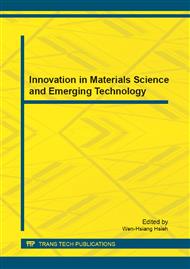[1]
Brownjohn, J.M.W., and Middleton, C. J., Procedures for vibration serviceability assessment of high-frequency floors, Engineering Structures, 30, (2008), p.1548–1559.
DOI: 10.1016/j.engstruct.2007.10.006
Google Scholar
[2]
El-Dardiry, E., and Ji, T., The Effect of Eccentricity on the Free Vibration of Composite Floors, Computers and Structures, Vol. 85, (2007), p.1647–1660.
DOI: 10.1016/j.compstruc.2007.02.020
Google Scholar
[3]
Pan, T. C., You, X., and Lim, C. L., Evaluation of Floor Vibration in a Biotechnology Laboratory Caused by Human Walking, Journal of Performance of Constructed Facilities, Vol. 22, No. 3, (2008), pp.122-130.
DOI: 10.1061/(asce)0887-3828(2008)22:3(122)
Google Scholar
[4]
Pavic, A., Miskovic, Z., and Reynolds, P., Modal Testing and Finite-Element Model Updating of a Lively Open-Plan Composite Building Floor, Journal of Structural Engineering, Vol. 133, No. 4, (2007), pp.550-558.
DOI: 10.1061/(asce)0733-9445(2007)133:4(550)
Google Scholar
[5]
Reda Taha, M. M., El-Dieb, A. S., Abd El-Wahab, M. A., and Abdel-Hameed, M. E., Mechanical, Fracture, and Microstructural Investigations of Rubber Concrete, Journal of Materials in Civil Engineering, Vol. 20, No. 10, (2008).
DOI: 10.1061/(asce)0899-1561(2008)20:10(640)
Google Scholar
[6]
Reynolds, P., The Effects of Raised Access Floor on the Vibrational Performance of Long-Span Concrete Floors, PhD. Dissertation at the University of Sheffield 2000 http: /vibration. shef. ac. uk/pdfs/PR_PhD. pdf.
Google Scholar
[7]
Reynolds, P., and Pavic, A., Effects of False Floors on Vibration Serviceability of Building Floors. I: Modal Properties, Journal of Performance of Constructed Facilities, Vol. 17, No. 2, (2003), pp.87-96.
DOI: 10.1061/(asce)0887-3828(2003)17:2(75)
Google Scholar
[8]
Reynolds, P., and Pavic, A., Effects of False Floors on Vibration Serviceability of Building Floors. II: Response to Pedestrian Excitation, Journal of Performance of Constructed Facilities, Vol. 17, No. 2, (2003), pp.87-96.
DOI: 10.1061/(asce)0887-3828(2003)17:2(87)
Google Scholar
[9]
Setareh, M., Vibration Serviceability of a Building Floor Structure. I: Dynamic Testing and Computer Modeling, Journal of Performance of Constructed Facilities, Vol. 24, No. 6, (2010), pp.497-507.
DOI: 10.1061/(asce)cf.1943-5509.0000134
Google Scholar
[10]
Setareh, M., Vibration Serviceability of a Building Floor Structure. II: Vibration Evaluation and Assessment, Journal of Performance of Constructed Facilities, Vol. 24, No. 6, (2010), pp.508-518.
DOI: 10.1061/(asce)cf.1943-5509.0000135
Google Scholar
[11]
Tsay,R. J. and R.L. Hawng-Ran, R. L., Research for the Effect of Admixtures to the Rubber Concrete Behavior, The 4th Asian Concrete Federation International Conference, Tapei, Taiwan, S1. 2-03, (2010).
Google Scholar


